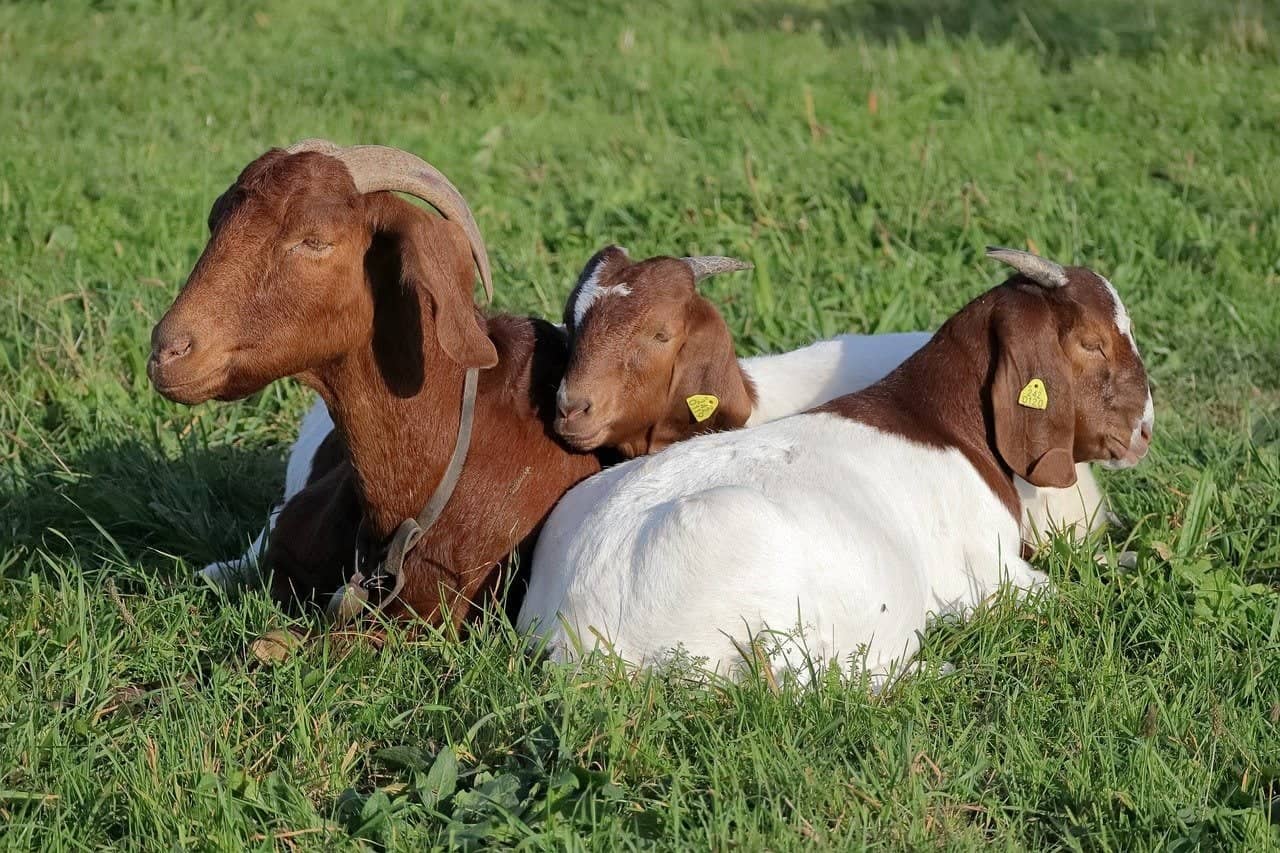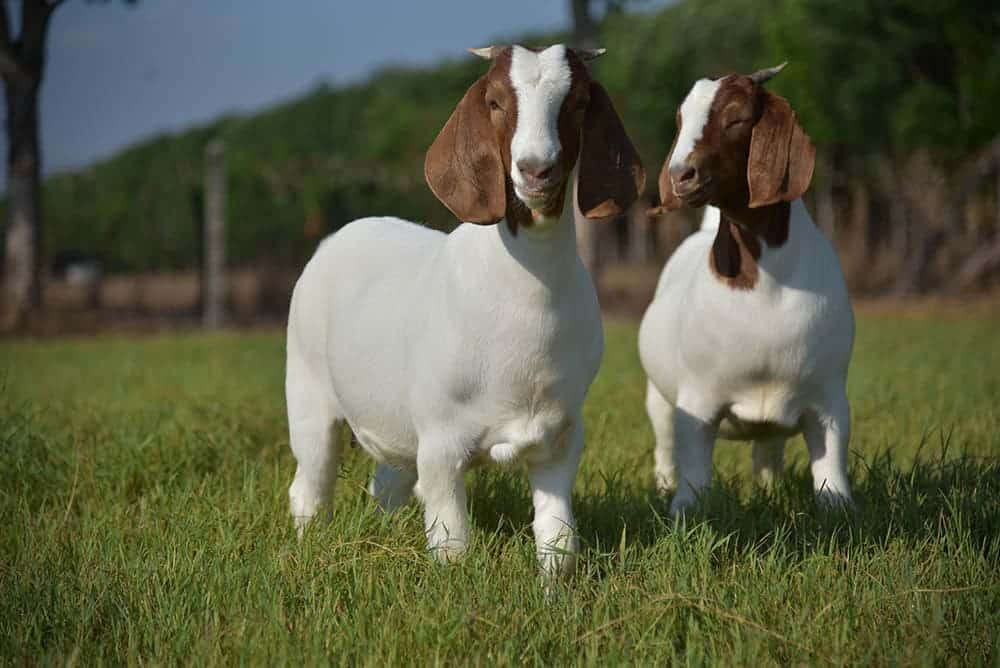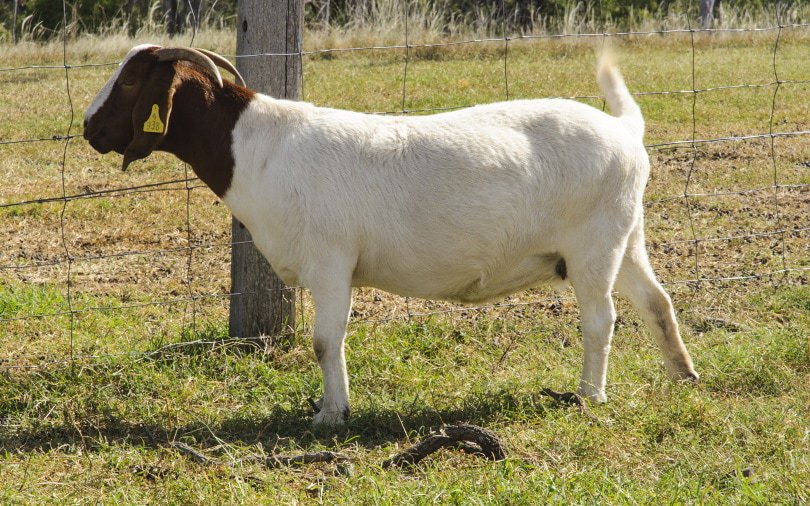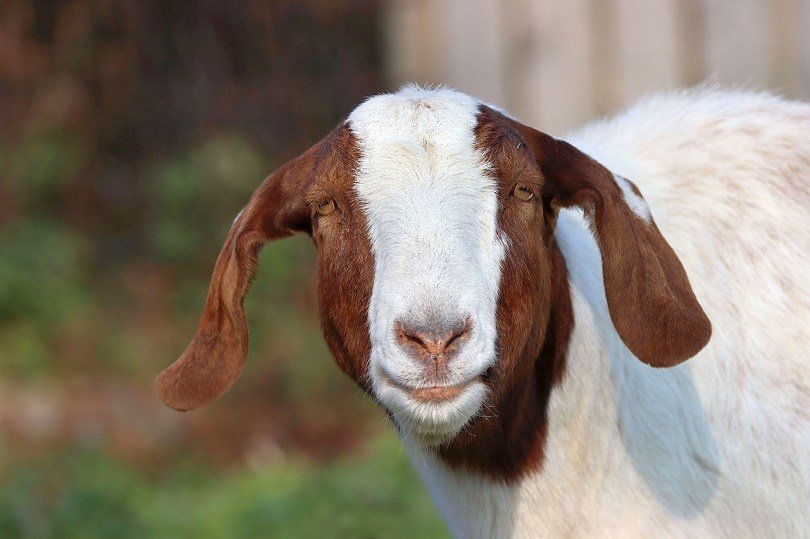The Boer goat is a South African goat that got its start in the early 1900s. Its main purpose is to provide meat, unlike many other breeds that give milk. It grows quickly and is often used for land management because its grazing can prevent bush encroachment, which can degrade rangeland for other livestock.
Keep reading while taking a closer look at the Boer goat.

Quick Facts about the Boer Goat
| Species Name: | Capra aegagrus hircus |
| Family: | Bovidae |
| Care Level: | Moderate |
| Temperature: | All climates |
| Temperament: | Calm and relaxed |
| Color Form: | White with a brown head |
| Lifespan: | 10–20 years |
| Size: | 30 inches tall; 200–350 pounds |
| Diet: | Shrubbery |
| Minimum Space: | 50–60 square feet |
Boer Goat Overview

Many breeders consider the Boer goat one of the top goat breeds for meat. The Boer has an easy-going personality and is gentle around people and other animals. It’s fast-growing, easy to maintain, and brings a nice profit. The only thing prohibiting this breed from being an ideal pet is that it prefers company, and most experts recommend having at least two, which can make for them expensive. It also needs a large area to graze.
How Much Do Boer Goats Cost?
You can expect to spend between $80 and $150 on your Boer goat. The price will vary depending on your location and how many goats you intend to purchase. Show winning goats can cost up to $2,000. There are a few other things to consider when thinking about the cost. You will need to purchase food, hay in the winter, and worming medicine. You will also need to purchase toys to keep your goat entertained when it’s bored so it avoids jumping the fence. These items add up to a considerable cost over the lifetime of your goat.

Typical Behavior & Temperament
Boer goats are easy to maintain because they calm and have a calm temperament. This goat is sociable and prefers to be in a group. It’s a favorite goat for land management because it doesn’t fight with others. It’s also one of the few sheep breeds that make a good pet, along with the Nigerian Dwarf and the Pygmy goat.
Appearance & Varieties
The Boer goat is a meat-giving goat with a white body with a red or brown head. It has long ears that droop down on the side of the head. It stands a little under 3 feet tall, and the males can reach more than 300 pounds.

How to Take Care of Boer Goat
Habitat Conditions & Setup
Your Boer goat will require a large area to roam and graze. Most experts recommend a pen with at least 50–60 square feet. It should also have an indoor enclosure of at least 15 square feet that provides heat and adequate shelter from the weather. There should also be plenty of fresh water inside the shelter and out.

Do Boer Goats Get Along with Other Pets?
Boers tend to get along well with other livestock. Some dog breeds and donkeys can become aggressive toward them, though, so it’s best to acclimate them slowly by allowing them to share only small amounts of time together at first to see how they get along. Boer goats can occasionally trample smaller animals like turkeys and geese.

What to Feed Your Boer Goat
Boer goats are primarily grazers that will eat small shrubbery. They tend to eat woody shrubbery, weeds, and other plants that cows will leave behind. Many farmers rotate the two animals to get the most out of their fields. Of course, we’ve all heard the stories about how goats will eat nearly anything, and for the most part, that’s true. However, you will need to keep your goat properly fed if you want to get the most money for the meat or the longest life for your pet.
Keeping Your Boer Goat Healthy
Parasites
Parasites are a major concern when owning a Boer goat. These goats have less immunity than other breeds, and worms can affect the liver, lungs, and other important organs. In particular, you need to worry about the Haemonchus contortus and Coccidia worms.
- Haemonchus Contortus – Haemonchus contortus can cause anemia in your Boer goat. You will need to check the mucous membranes around the eyes to see if they are pale. If so, it could be a sign your goat has these worms.
- Coccidia – Coccidia is the most common cause of diarrhea in Boer goats. With this condition, a microscopic parasite attacks the animal’s intestines and lays a large number of eggs. It spreads to other goats from the feces and contaminated water, so you will need to isolate the infected goats as soon as possible. Coccidia is a bigger problem for young goats than adults, as most adults have a small amount of Coccidia in their system.
Foot Rot
Foot-rot is another major concern for any Boer goat owners. As the name suggests, this condition causes the hooves to deteriorate, leading to lameness. Micro-organisms in the soil cause this condition, and it enters the body through irritated toes. The hard and frozen ground will contribute to the irritation, and it’s easier to spread in moist conditions. Treatment includes isolation and trimming the hooves.

Foot Scald
Foot scald is another problem that can affect the feet of your Boer goat. A bacteria causes this infection, and you can find it on any grazing pasture and is spread through feces. It also spreads faster when the ground is wet and will lead to lameness, weight loss, and other health issues. You will need to separate and trim the hooves of infected goats.
Breeding
You can expect baby Boer goats to grow as fast and as large as the parents. This interesting fact makes it easy to know what you are getting when you make a purchase. If you are breeding your goats, you will need to provide time for the mother to take care of the kid, and you will also need to vaccinate the babies to protect them from disease.

Are Boer Goats Suitable For You?
Boer goats are great as a pet or for working the land to keep it free of bushes and other woody vegetation. It also produces high-quality meat.
We hope you have enjoyed our look into this popular breed of goat and have found the answers you need. If you or someone you know is thinking about getting one of these animals, please share this guide to the Boer goat on Facebook and Twitter.
Featured Image Credit: Uschi_Du, Pixabay
